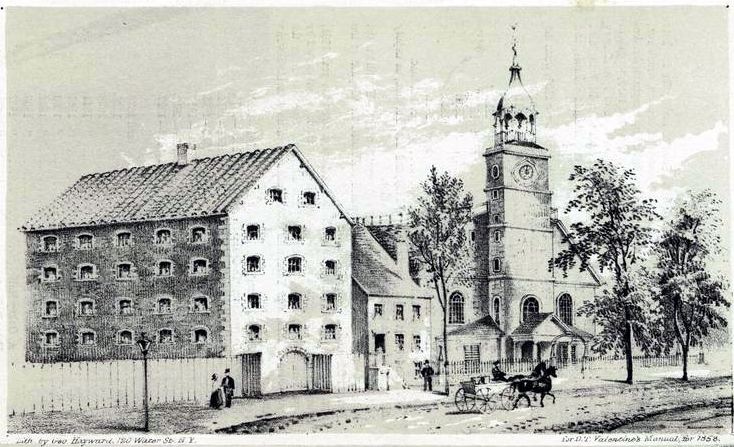 | ||
Sugar houses in New York City were used as prisons by occupying British forces during the American Revolutionary War. Out of 2,600 prisoners of war captured during the Battle of Fort Washington in November 1776, 1,900 would die in the following months at makeshift prisons throughout the city. At least 17,500 are estimated to have perished under substandard conditions of such sugar houses and British prison ships over the course of the war, more than double that of casualties from battle.
Contents
Background
During the 18th century, a large part of commerce in New York City was trade with the British West Indies. Destined for refineries, sugar and molasses imported from Jamaica and Sint Eustatius were stored in warehouses built by merchant families, such as the Bayards, Cuylers, Livingstons, Rhinelanders, Roosevelts, and the Van Cortlands. Three of these large structures were known for being used by the British Army to house prisoners of war during their occupation of New York City in the midst of the American Revolution.
Livingston's sugar house
The sugar house on Crown (now Liberty) Street in Manhattan was a six-story stone building which had been built in 1754 by the Livingston family as a refinery with very low floors. According to Revolutionary War veteran Levi Hanford, who was captured in March 1777, the cramped conditions initially housed about 40 to 50 prisoners. The population soon swelled to between 400 and 500, though attrition was constant due to those succumbing to illness. Rations consisted of pork and sea biscuits, which were often moldy from sea water and infested with worms. Nevertheless, the starving prisoners seldom refused the food, which was made consumable by placing it in a kettle of water and skimming off the parasites. Supplies for sick prisoners were provided by the fledgling American government, as Hanford stated that "the British furnished nothing." Deceased prisoners were sewn up into their blankets and placed in a corner of the yard for pickup by a dead cart in the morning; as many as fifteen bodies once accumulated in the period of one day. Prisoner exchanges were organized with the oldest prisoners having priority. The structure was later demolished in 1846. The site is now occupied by buildings numbered 34 and 36.
Rhinelander's sugar house
The sugar house on the corner of Rose (now William) Street and Duane Street in Lower Manhattan was a five-story brick warehouse. Built in 1763 by William Rhinelander, the structure originally stored molasses and sugar next to his own residence. During the Revolutionary War it is believed to have been used by the British army as a prison. When the building fell into disrepair during the early 19th century, locals believed it to be haunted by ghosts of prisoners from the war. However, Brooklyn history professor Edwin G. Burrows believes this sugar house was not used as a prison and that the legend may have originated from local historian Charles I. Bushnell. The old warehouse was replaced by the Rhinelander building, which retained part of the original wall from 1892 to 1968, and continued to receive reports of ghostly sightings in a window. The site is now occupied by the headquarters of the New York City Police Department, near which one of the original barred windows was retained. A section of wall with another window was moved to Van Cortlandt Park in the Bronx.
Van Cortlandt's sugar house
The sugar house on the northwest corner of the yard of Trinity Church in Manhattan was built by John Van Cortlandt and partner George Petterson around 1755; Van Cortlandt took sole proprietorship after their partnership was dissolved two years later. Used as a prison during the Revolutionary War, the building was later torn down in 1852.
